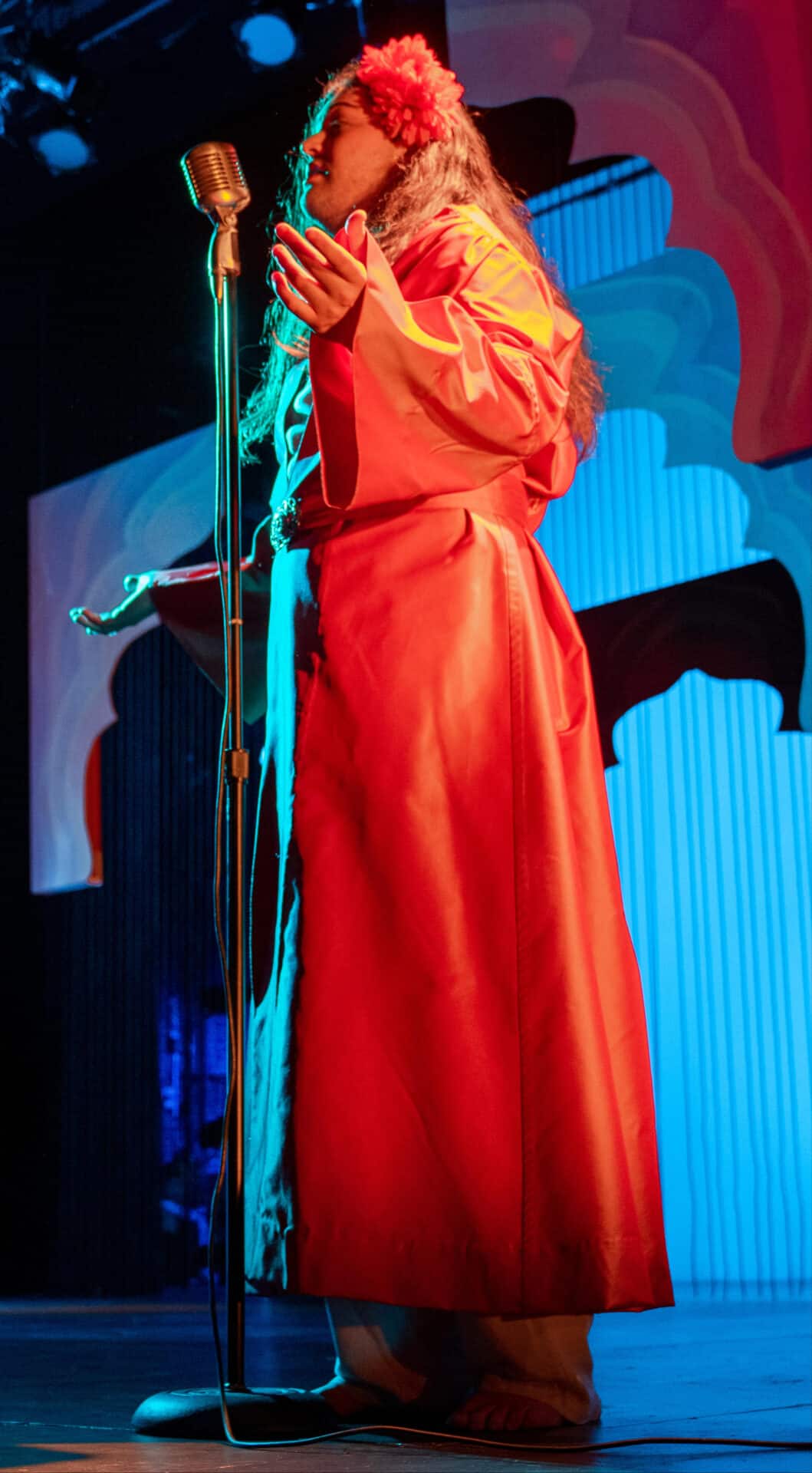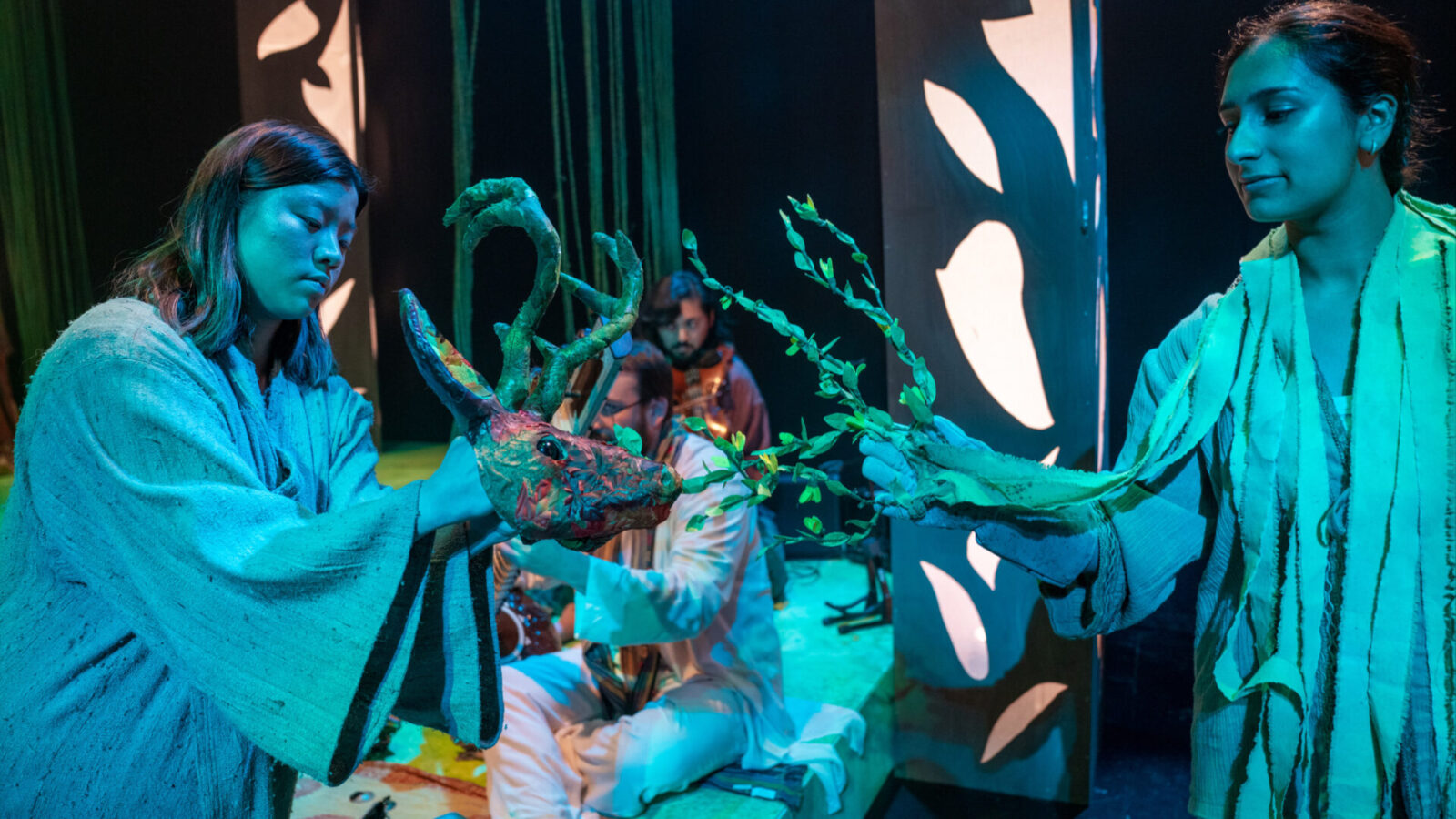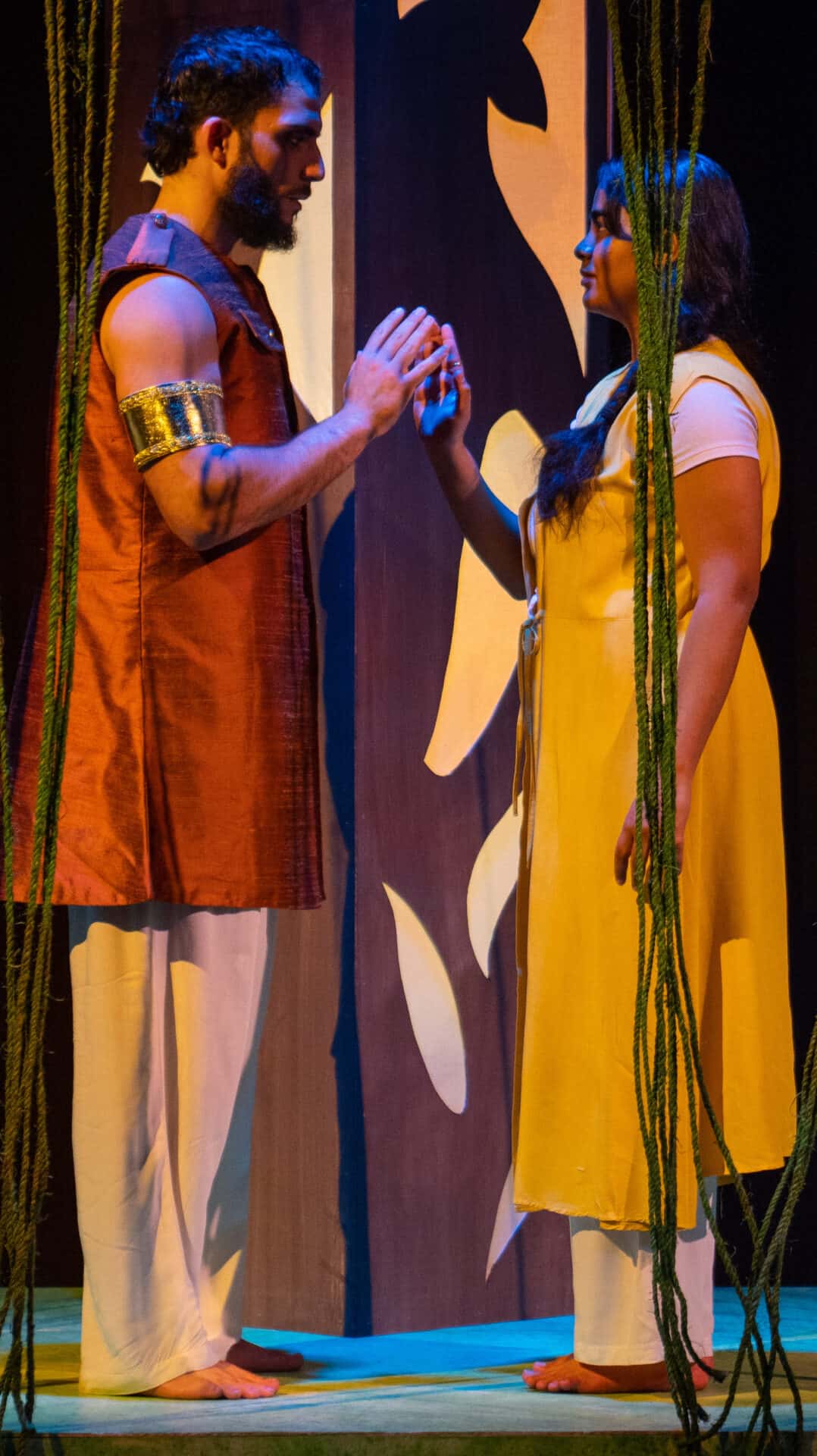A doe is running through the trees — a mask, a puppet in the leaf shadows. Live music hums on sitar and carnatic violin, and we’re sitting in the middle of the woods, in the middle of the stage — the audience who made it into the sold-out opening night of Shakuntala: A Remix at the Williams College ’62 Center.
They’re remixing a 4th-century Sanskrit play. Williams professor of theater Shanti Pillai has gathered together an ensemble of student actors and guest artists, musicians, puppeteers, a Bollywood choreographer, and they are creating a new work together.
Williams professor of theater Shanti Pillai has gathered together an ensemble of student actors and guest artists, musicians, puppeteers, a Bollywood choreographer …
With respect for the original — the epic by Kalidasa, one of the best-known voices in classic Indian literature — they are understanding his work in their own lives and improvising in their own words.
They are weaving time and space, traditional and contemporary traditions as fluidly as Saumya Shinde ’26 tells us a jasmine vine winds around a mango tree. In this moment, she is playing Shakuntala, the title character, watering trees in a forest hermitage, as two close friends, Hung Ho and K Wolfson, are teasing her and each other in easy intimacy.
The play opens as prince comes hunting the deer. Jonas Echeandia ’23 comes in running, with a pith helmet and a shotgun slung over his shoulder. In the woods, he sets the gun down.
He meets the foster daughter of a hermit ascetic. Shakuntala is daughter of a forest spirit and a holy man of a mental clarity strong enough to catch the eyes of gods. Shinde, an international student from Mumbai, is playing her with mischief and the fluent expression from her background in classical Indian dance — a young woman tapping possibilities in herself she has not yet explored.
Across three acts, in three times and places, the ensemble makes depths of feeling tangible — as real as rain and the scent of jasmine in flower and the strength of love in a college summer — or in a relationship that has grown and rooted.

Mark Gomes performs as the prince in the final act of Shakuntala: A Remix. Press photo courtesy of the '62 Center at Williams College
Something in her and in this woodland has the prince’s attention. Away from his courtiers, he finds ways to see the world and himself differently, as Shakuntala is wrestling with experiences she has seen in the forest around her but hasn’t felt in her own body.
They are young people in the grip of desire, and they are more than that. He sees a barefoot woman watering trees, bottle-feeding a fawn, dancing with bees. And the woods feel familiar, alive, complex, when he is with her.
Or he is now. As the play moves on, actors will change roles. A wild goose in one scene may become the king’s laughing young son. A prince captivated by the woods goes back to the city, and French teaching associate Danae Tsiamis picks up the role in the middle of a party.

E Wolfson sings in vivid light in Shakuntala: A Remix. Press photo courtesy of the '62 Center at Williams College
The audience walks into the center stage and into the energy of a club. Music and sound designer Luke Shanty has put down his sitar to DJ live, and the modest ascetics are turning into courtesans dancing with a gleeful abandon.
They dance together, playing on each other’s energy freely and confidently, and we can feel the group relaxing around us. They’re bantering in motion, staging friendly competitions to catch the prince’s attention, tossing the limelight back and forth. E Wolfson sings in a high, clear tenor vast enough to fill the center stage
But the prince is troubled. For him the party has gone hollow. He doesn’t know that he has been cursed to forget his time in the forest (though we do). But he knows something has changed in him. When a young woman appears, demanding that he recognize her unborn child as his heir, he can’t find her in his memory, but he knows her in his bones.
As Tsiamis takes up his voice, she carries a shift in feeling and setting highlighted against the vivid lights, international playlist and contemporary dance moves. This kind of fluid movement of roles can deepen a character, and it grows from a long tradition in classical Indian theater and dance, among others.
We have seen in the first scene, when one of the musicians sets down his bow and steps in as Shakuntala’s father. Sean Devare is an artist in residence at Williams this semester, with a focus on re-interpreting myth and folklore through masks, puppetry and ancient performance traditions, and he has performed in many countries — Bali, India, Ecuador and Sicily.
Here he as been playing a soothing forest soundscape as the young lovers held their scenes around him. And in a breath he moves into the center of the scene as a father having to say goodbye to his daughter as she leaves home.
And now we see time shimmer and echo in the final scene. We step into Shakuntala’s mother’s home, where birds glide like kites and an elephant walks on stilts. We know that time has passed, and the prince, after long searching, has found a child chasing a lion and laughing.
We know time has passed because the prince’s role has passed to Mark Gomes. A guest actor and assistant professor of acting at Ithaca College, he performs with Pillai through Third Space Performance Lab. And here the two of them become the prince and Shakuntala, meeting again.
We see the prince realizing that the laughing child is his own. Without words, he is taking off his arm-band and giving it to the boy in the recognition Shakuntala asked of him before she gave herself to him in the forest. In silence, he sees her now standing on the pathway above him, and is walking up the stair to meet her.
They come together in silence, and around them we hear the voices of the earlier Shakuntalas and princes speaking in waves of understanding and resolution, as though the present ones have come so far they can talk now without words.


